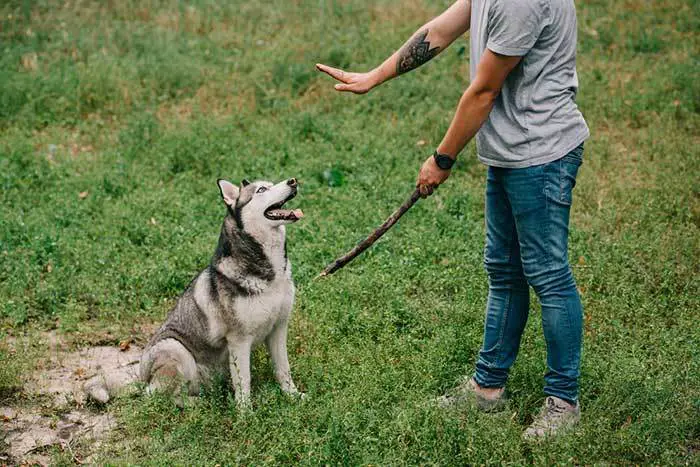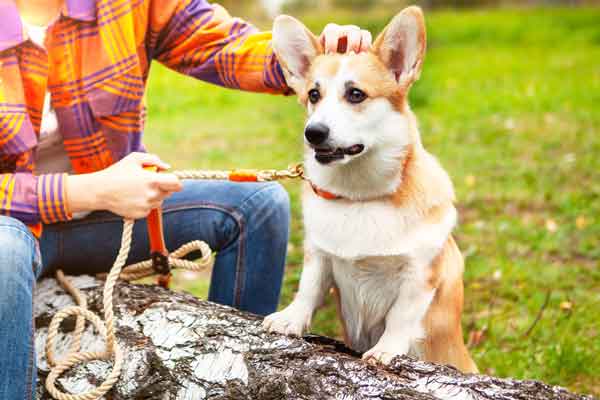Training a dog to not bite people is no small feat and can be especially difficult if the biting has become a habit. While some techniques like positive reinforcement are helpful, it’s important to understand why your pup might be biting in the first place so that you can tackle the underlying issue properly.
In this blog post, we will dive into how to effectively train your dog to use their mouth gently with humans (and animals!) outside of playtime—including what causes dogs to bite, signs that they may do it again soon, and best practices for dealing with it when it happens.
With some patience and consistent effort, you should have a pooch who shows respect during interactions with others in no time!
Building a positive relationship with your dog doesn’t have to be complicated. By using treats and praise as rewards, you can show your furry friend how much you appreciate their good behavior.
Positive reinforcement encourages your pup to keep up the good work and reinforces that biting isn’t acceptable. When they exhibit gentle behavior, make sure to reward them with treats and verbal praise.
A reputable personal injury lawyer notes that dog bite cases could lead to serious legal issues if not managed properly. This is why it’s important to take the time and energy to properly train your pup with positive reinforcement from an early age. If your pup has already formed a habit of biting, it will take more patience and practice to break them out of their comfort zone.

1. Use verbal commands to instruct the dog to stop biting or nipping
As dog owners, one of the most common problems we encounter is biting and nipping. Although these may seem like innocent actions, they can quickly escalate into a dangerous situation.
To teach your dog to stop biting or nipping, you can use verbal commands. The most effective way to do this is to use a firm, clear voice and say “no” or “stop” with authority. Be sure to follow through with positive reinforcement when your dog responds correctly to these commands.
Remember, consistency is key when training your furry friend. With patience and persistence, you can successfully teach your dog to stop biting and enjoy a peaceful and happy life together. Dog muzzles can be a great way to prevent unwanted biting and nipping, but it is best used as a last resort.
2. Implement physical cues
Training your puppy not to bite can be challenging, but incorporating physical cues can make all the difference. Rather than scolding or shouting, try gently tugging on the leash or pushing down on their shoulder when they start to bite. This physical touch can serve as a reminder that biting is not acceptable behavior.
With patience and consistency, you can teach your furry friend that there are other ways to play and communicate without using their teeth.
By implementing these techniques, you can build a stronger bond with your pup and create a safer environment for both them and those around them. If you find that your pup is still struggling with the biting, you may need to seek additional professional help.
3. Provide plenty of chew toys for them to gnaw on instead of people’s hands
Puppies are lively and energetic creatures who love to play and explore their surroundings. However, sometimes they can get a little too excited and start biting or nipping at people’s hands or other objects. This behavior may seem harmless, but it can quickly become a problem and lead to injuries. That’s why it’s important to provide plenty of chew toys for your puppy to gnaw on instead of people’s hands.
Chew toys not only help satisfy your puppy’s natural urge to chew but also prevent them from causing harm to others. With a variety of chew toys to choose from, such as rubber bones, rope toys, and treat-dispensing balls, your puppy will have endless fun and entertainment while keeping their teeth healthy and strong. So, give your furry friend the gift of safe chewing and watch them thrive!
4. Make sure your dog is getting enough exercise
Dogs are one of the most beloved and cherished animals in the world, and for good reason. They are not only loyal companions but also bring joy and happiness to our lives. However, without proper care and attention, dogs can develop behavioral issues such as biting.
One of the easiest ways to prevent this is by making sure your pup gets enough exercise, as a lack of physical activity can lead to pent-up energy which may manifest in negative behavior. Taking them for regular walks, playing fetch in the park, and engaging in other interactive activities are some great ways to keep your four-legged friend happy and healthy.
With enough exercise and love, your pup will be less prone to biting and more likely to have a positive attitude towards life!
5. Stick with positive reinforcement
Maintaining discipline is essential when training a dog, but it’s important to do so in the right way. Punishing bad behavior with violence or physical force should be avoided as this can lead to more aggressive behavior.
Instead, use positive reinforcement by rewarding good behavior with treats and praise. If your pup does something wrong, such as biting, give them a timeout instead of punishing them. Timeouts involve removing your pup from the situation and providing them with a calm, quiet space for a few minutes. This allows them to reflect on their behavior and encourages them to think twice before doing it again.
With consistency and positive reinforcement, you can help create an environment where biting is not acceptable behavior.

To gain a positive relationship with your dog, it pays to be consistent in the tools and methods you use. Most of all, with any creature, giving them love and patience will pay off many dividends- both for them and for yourself.
A great way to bond with your pet is through walks and playtime in the park. Allowing your pet enough time to work off excess energy can help prevent destructive behavior. Positive reinforcement such as treats or toys should be used when teaching your pup basic commands; punishing bad behavior with violence is not recommended.
Above all else, remember to also give them hugs and cuddles from time to time! With these tips, you’ll be well on your way toward having a happy, healthy pup that will bring joy into your home or wherever else you may choose to take them!

